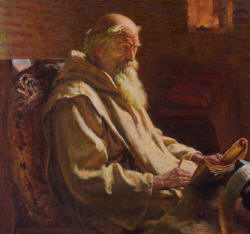
The Ecclesiastical History Of The English Nation -Venerable Bede
CHAP. XVII
OF THE PLACE OF OUR LORD’S ASCENSION, AND THE TOMBS OF THE PATRIARCHS
CONCERNING the place of our Lord’s ascension, the aforesaid author writes thus. “Mount Olivet is equal in height to Mount Sion, but exceeds it in breadth and length; bearing few trees besides vines and olive trees, and is fruitful in wheat and barley, for the nature of that soil is not calculated for bearing things of large or heavy growth, but grass and flowers. On the very top of it, where our Lord ascended into heaven, is a large round church, having about it three vaulted porches. For the inner house could not be vaulted and covered, because of the passage of our Lord’s body; but it has an altar on the east side, covered with a narrow roof. In the midst of it are to be seen the last prints of our Lord’s feet, the sky appearing open above where he ascended; and though the earth is daily carried away by believers, yet still it remains as before, and retains the same impression of the feet. Near this lies an iron wheel, as high as a man’s neck, having an entrance towards the west, with a great lamp hanging above it on a pulley, and burning night and day. In the western part of the same church are eight windows; and eight lamps, hanging opposite to them by cords, cast their light through the glass as far as Jerusalem; this light is said to strike the hearts of the beholders with a sort of joy and humility. Every year; on the day of the Ascension, when mass is ended, a strong blast of wind is said to come down, and to cast to the ground all that are in the church.”
Of the situation of Hebron, and the tombs of the fathers, he writes thus. “Hebron, once the city and metropolis of David’s kingdom, now only showing what it was by its ruins, has, one furlong to the east of it, a double cave in the valley, where the tombs of the patriarchs are enclosed with a square wall, their heads lying to the north. Each of the tombs is covered with a single stone, worked like the stones of a church, and of a white colour, for three patriarchs. Adam’s is of more mean and common workmanship, and lies not far from them at the farthest northern extremity. There are also some poorer and smaller monuments of three women. The hill Mamre is a thousand paces from the monuments, and is full of grass and flowers, having a flat plain on the top. In the northern part of it, Abraham’s oak, being a stump about twice as high as a man, is enclosed in a church.”
Thus much have we collected from the works of the aforesaid writer, keeping to the sense of his words, but more briefly delivered, and have thought fit to insert in our History. Whosoever desires to see more of the contents of that book, may see it either in the same, or in that which we have lately epitomized from it.

 Support Site Improvements
Support Site Improvements